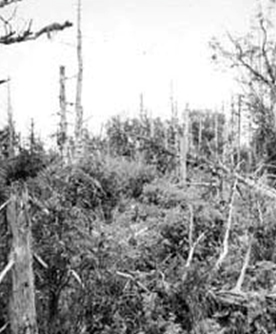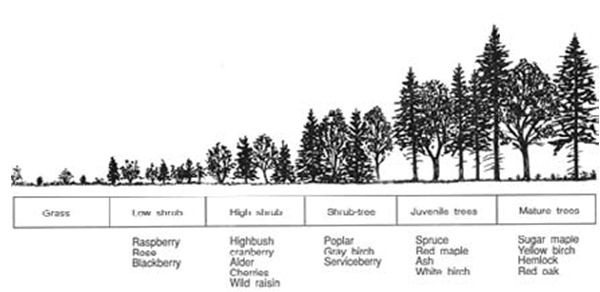Module 7: Woodlot Ecology: Your Living Woodlot
Lesson Three - Forest Ecosystems
Think of the community in which you live. Most likely, individuals, and groups of individuals, interact with each other and with the environment around them. Forest ecosystems are similar, with single organisms - or groups of them - interacting with other organisms and adapting to the environment in which they live.
Forest ecosystems might exist in a pool of water, on the bark of a tree or under a decaying log. Many of the organisms may be microscopic. Other ecosystems may contain organisms as large as trees and encompass several hectares of forest. In both cases, individuals have adapted to their environment and to each other.
 |
|
| Figure 19 - Ecosystems come in all sizes and shapes. These decay-ing logs support whole ecosystems of species. |
The place or role that individuals or groups occupy in an ecosystem is called a niche. These roles are essential to ensure the proper functioning of the ecosystem.
When we think of forest ecosystems, we often think of wildlife. Small mammals like moles, shrews, and chipmunks loosen the soil and move decomposing material when they tunnel and burrow. Forest floor litter eaten by these animals passes through their digestive systems where it meets new chemicals which help break down material.
Many different wildlife species depend on each other. Aphids and ants often live and work together. Ants protect the aphids and in return receive a food supply of "honeydew" from the aphids. Bacteria living in the stomach of deer depend on the deer's stomach for warmth and the deer need the bacteria to digest food.
Insects are important members of forest ecosystems. They pollinate plants, feed on waste, provide a food source for other animals, and also eat other insects. Some insects feed on trees but these are a very small part of the forest insect community. In Nova Scotia some 10,000 species of insects live in our forests.
An edge is created where one ecosystem meets another. This may be where a forested area meets a watercourse or it may be a place where two different communities of plants or trees meet. For example, an edge is created where a spruce stand meets an open field. Edges can also be man made
-for example, where a harvested forest meets an uncut forest. The size and shape of the forest cut determines the amount of edge.
Generally, edges are very important for wildlife because they offer more choices for food, water, cover, and space requirements. The areas in which wildlife can find these necessities of life are called habitat. Near edges, wildlife has simultaneous access to both kinds of habitat, and can quickly move away if necessary. As a result, wildlife is often more numerous near edge areas of a woodlot.
 |
|
| Figure 20 - Edges are where two types of wildlife habitats meet. |
Not all species in an ecosystem are equally dominant. In an ecosystem of many hundreds, only a few species exert a controlling influence over the rest of the ecosystem. The dominant species are those that are most successful and which influence the presence of other kinds of plants and animals. For example, the kinds of plants that grow on the forest floor are determined in part by the trees. Small plants, like mayflowers or dogtooth violets, flower early in spring when the maple leaves are just budding and there is little shade. In spruce and fir-dominated forests where shade is considerable, plants which require less light will grow.
Differences between terrestrial ecosystems are most easily determined by observing the types of vegetation occupying a forest site. A community is composed of common groups of vegetation that normally occur together. Sample communities of trees in Nova Scotia include spruce and balsam fir, spruce and white pine, and yellow birch and red maple. Even communities that have much in common can have differences because the forest is always changing or being disturbed, or the soil or climate may vary. These factors alter the growth pattern of forest stands so that one group of balsam fir and spruce may be slightly different from another or vary from one woodlot to the next.
Succession
The change in species and community structure over time is called succession. Examples of succession are easy to identify: the return of abandoned farmland to forest is a good example.
Abandoned agricultural land goes through a fairly predictable process of succession. Herbs and shrubs like goldenrod, speckled alder (which fixes nitrogen) and meadow-sweet become established on old fields within a few years of abandonment. White spruce, tamarack and trembling aspen may follow shortly afterward, depending on the soil moisture content and available nutrients. The old fields are transformed, over 20 or 30 years, into a young forest.
 |
|
| Figure 21 - Old fields go through predictable stages of succession. This is a common sight throughout Nova Scotia. |
Succession can also occur on harvested forest sites, or clearcuts. These areas have had most or all of the trees removed. Over time, most of these sites will regenerate to a new forest.
 |
|
| Figure 22 -Most clearcuts will regenerate with Acadian Forest tree species. |
Succession in harvested forest areas results in more complex communities of trees, shrubs and herbs than on old fields.
Forested sites that are not harvested are often impacted by natural disturbances such as wind, fire and insect outbreaks. In the past, the forests of Nova Scotia were constantly changing as these natural forces created gaps in the forest. Many of these gaps were fairly small as individual trees blew down, or were quite large as fire swept through hundreds of hectares of forest. These sites are examples of succession.
 |
|
| Figure 23 -This forest stand has been killed by a white-marked tussock moth outbreak, and has begun to regenerate. |
As seen by these examples, succession brings about changes in the diversity of ecosystems: they usually become more complex over time, until they reach a climax state that changes very little over time. In forests, an example of a climax ecosystem is an old-growth forest.
 |
|
| Figure 23 -Old growth forests are stable ecosystems. |
Balsam fir forests can also exhibit stability, with regeneration succeeding over-mature and dying fir. This forest type is continually renewing itself. Spruce budworm outbreaks are periodic, recurring at 35- to 40-year intervals, and are part of the natural cycle of events associated with the maturing of balsam fir. Human interaction, too, allows for natural regeneration of the balsam fir forest, by harvesting trees when they are mature. Such disturbances can maintain the stability of forest ecosystems.
In Nova Scotia, succession in most natural forest ecosystems is interrupted by disturbances such as wind, insect outbreaks and tree harvesting. More than 200 years ago, fire likely played a larger role in defining forest communities than it does today. With prompt and effective modern fire suppression, fires are less important today in shaping forest ecosystems. As a result some fire-dependent ecosystems may become less common as time goes by.
 |
|
| Figure 24a -Changes in the forest: successional stages. |
Classifying Forest Ecosystems
Forest Ecosystem Classification is a useful tool that lets you identify vegetation types, soil types and ecositess on your woodlot. Forest Ecosystem Classification is based in the identification of ecosites by considering the soil types and vegetation structure of your woodlot. Ecosites are groups of communities which have developed under similar moisture and nutrient conditions. In forests, moisture and nutrients are two important controlling factors in the growth of trees and other vegetation. Similar ecosites may be found over a wide geographic area.
 |
|
| Figure 25 -Nova Scotia's new Forest Ecosystem Classification guide. |
In forests, trees are the most obvious forms of vegetation. Vegetation types are identified by observing the tree species and the shrubs and other plants that live there.
At a landscape level, ecosystem classification can be used as a tool for landscape planning which can then be ecologically linked to forest operations and stand-level planning. NSDNR has already produced a comprehensive ecological landscape classification (ELC) system for Nova Scotia. This system begins with ecozone and moves through ecoregions, ecodistricts, ecosections, and finally ecosites - the level where the ELC and Forest Ecosystem Classification systems converge.
At a stand level, classifying forest ecosystems based on vegetation, soil, and site conditions allows forest professionals to recognize similar ecosystem units on the ground and to develop a common understanding of these units. This allows for further development of guidelines and best management practices, and leads to more predictable and sustainable forest management.
Vegetation Types are recurring and identifiable forest plant communities which re?ect differences in site conditions, disturbances, and succession.
Soil Types are soils that can be identified by texture, drainage, fertility, and depth, all of which in?uence site productivity.
Ecosites are units which represent ecosystems that have developed under a variety of conditions and in?uences, but which have similar moisture and nutrient regimes. An ecosite is associated with a range of soil and site conditions and a range of vegetation types that grow naturally under those conditions.
 |
|
| Figure 26 -There are more than 80 different forest vegetation types identified in Nova Scotia, including this Red oak-White pine/teaberry type. |
Many different vegetation types exist in Nova Scotia, and these have been classified according to their moisture regimes and availability of nutrients by the Nova Scotia Department of Natural Resources. By classifying forest ecosystems based on vegetation, soil and site attributes, woodlot owners and others can learn to recognize ecosystems and have a better understanding of the ways in which those ecosystems function. It also helps them predict which woodlot management treatments will work best on particular sites.
